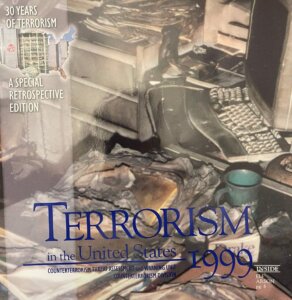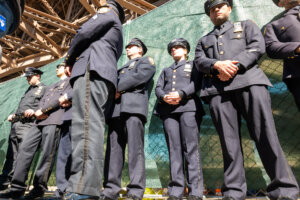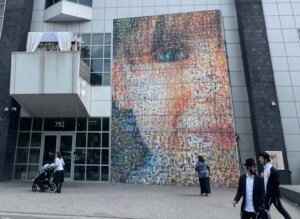The untold story of the worst attack on Jews in NYC history: Was there a conspiracy?
30 years later, the mother of the Lubavitcher boy who was murdered is still angry, still mourning and still seeking justice — and the truth

Devorah Halberstam with a photo of her son Ari, who was fatally shot on the Brooklyn Bridge in 1994. Photo by Beth Harpaz
It’s been 30 years since 16-year-old Ari Halberstam was murdered by a cab driver who shot up a van taking Lubavitcher kids across the Brooklyn Bridge. The gunman, Rashid Baz, died in prison last year while serving a 141-year sentence.
But Ari’s mother, Devorah Halberstam, wants you to know that the full story has yet to be told.
“I’m still fighting for justice for Ari,” she said in an interview in her home in Crown Heights, Brooklyn, where the first thing you see in the living room is a photo of teenage Ari, frozen in time.
“Everything was minimized and contained: I had to fight to have it classified as terrorism,” she continued. “I know all the pieces of the puzzle. And I’ll never understand: Who were we protecting? All the evidence was there.”
Among the “obvious questions” she’s angry that Baz never answered: “How’d you get the guns? Why were you on the bridge at the same time as the van? You just bumped into them? You just happened to be fully loaded with a machine gun, a Glock pistol and a ‘street sweeper’ .380, and you said, ‘Oh, Hasids on the bus, let me shoot them up.’”
And, most important: “Who else was in on it?”
Was there a conspiracy?
Halberstam called the shooting an act of terror from the outset, but it took five years for the FBI and the U.S. Department of Justice to classify the case as terrorism. The government still rejects Halberstam’s contention that Baz was part of a conspiracy. But the Anti-Defamation League posted a new $50,000 reward last year for information in the case, saying: “The question remains: Were others involved?”
I sent a detailed request to the U.S. attorney’s office for comment on this story, but did not hear back.
Why, one might ask, does any of this matter now? Baz is dead. And Halberstam has spent the last three decades getting antiterrorism laws passed. She also co-founded a Jewish children’s museum in Ari’s memory. So what more does she want, this woman who tears up in a nanosecond at the mention of her first-born son — a basketball player who made everyone laugh, a child who taught his Hasidic mother that you can be, in Halberstams’s words, “deeply religious” and at the same time, “an all-American kid”?
What could she possibly expect from the meetings she still holds with government officials, badgering them about a case they closed the book on years ago?
What she wants, she said, is the truth: “The truth doesn’t go away. And it needs to be told over and over.”
FOIA requests denied
As a Jewish New Yorker myself, and as a reporter who covered the Lubavitcher community — including the Crown Heights riots — for The Associated Press in the 1990s, I’ve followed this case for a long time. I’ve filed Freedom of Information Act requests with various governmental agencies over the years, hoping for answers to Halberstam’s questions. But all I’ve gotten is a few unenlightening pages related to the deportation of Baz’s uncle to Jordan. He and another man concealed evidence by repairing Baz’s shot-up car.
I thought this year might be different. Why keep things classified 30 years later if the government believes there was no conspiracy?
The reason given: “national security.”
I appealed, arguing that the public has a right to know and questioning the logic of keeping anything secret this many years on. How come I can read all about the government’s failures in preventing 9/11 and the murders of 3,000 people, but a March 14, 1994, cable labeled “Terrorist Threat Warning System in the United States” in an online archive of Halberstam documents remains classified?
So far I’ve lost my appeals.
“I hope you write that in your article,” Halberstam said. “They’re hiding something.”
Revenge for the Hebron massacre

Authorities initially characterized Baz’s 1994 attack as “road rage” following a traffic dispute. Then at trial, the defense said that Baz, who was Lebanese, was traumatized growing up during that country’s civil war, and that a “flashback” prompted him to shoot when he saw the boys in the van wearing the black hats and coats marking them as Jews.
Baz’s lawyer also said he was angry over a massacre of 29 Palestinians in the West Bank city of Hebron, carried out by religious extremist Baruch Goldstein five days before the bridge shooting. Baz’s mother was Palestinian.
Witnesses testified that Baz heard a “raging antisemitic sermon” at a Brooklyn mosque hours after the Hebron massacre. “This takes the mask off the Jews,” the imam reportedly said. “It shows them to be racist and fascist and as bad as the Nazis. Palestinians are suffering from the occupation, and it’s time to end it.”
Years later, Baz told the authorities: “I only shot them because they were Jewish.” That admission stands in stark contrast to a police investigator’s comment, early on, that Baz had “no politics and no real religion.” One lawyer described Baz as simply “nuts.”
“But he wasn’t,” Halberstam said. “He was crazy as a fox, as all terrorists are. He did this with intent.”
‘It wasn’t a coincidence’

It was widely known in Crown Heights that the Lubavitcher rebbe, Menachem Schneerson, then age 91, was having surgery at Manhattan Eye, Ear and Throat Hospital on the day the shooting took place. Halberstam believes Baz got wind of the appointment and staked out the rebbe to avenge the Hebron massacre.
Halberstam thinks the authorities had an inkling something was up because police stopped by Chabad headquarters the night before, telling people not to follow the rebbe’s motorcade “for security reasons.”
After the rebbe left the hospital, his entourage entered the Brooklyn Battery Tunnel in Manhattan to take him home, and officials temporarily blocked the tunnel to other cars. Baz, driving his cab, “couldn’t get into the tunnel after the rebbe,” Halberstam said, so he headed to the nearest alternate route: the Brooklyn Bridge. “It wasn’t a coincidence that he bumped into this van,” she said.
Halberstam believes Baz targeted the Jewish boys wearing black hats and coats as a substitute for the rebbe. He shot 40 rounds at the van while driving. Ari was one of four boys hit, and the only one to die.
Baz fled back to Brooklyn where his uncle, who owned the car, helped remove the shattered windshield. Where Baz got the ammunition and guns — which he claimed he kept in the cab for self-defense after being robbed — remains unknown.
Civil rights
Halberstam said the case of Ahmaud Arbery, the Black jogger murdered in Georgia in 2020 by two white men, “was an eye-opener for me.” Arbery’s mother successfully fought to have that case prosecuted on federal hate crime charges, not just murder.
Halberstam feels the bridge shooting — which she describes as the “worst attack on Jews in the history of New York City” — should also have been investigated by the feds as a violation of the boys’ civil rights, and not simply a shooting under state law.

“My son was murdered because he was identifiable as a Jew,” she said. “So is there a double standard because they were Jews? That’s the very big question in retrospect.” In other words, she believes antisemitism, on the part of investigators and prosecutors, may have influenced how the case was handled.
But she said she understands why the case wasn’t immediately classified as terrorism: “Terrorism was on nobody’s radar screen in 1994.” The first World Trade Center bombing had taken place the year before, killing six people and injuring more than 1,000, “but they treated that as isolated.”
Still, at a commemoration held at the bridge on the 30th anniversary of the attack, New York Mayor Eric Adams said Halberstam was prescient in calling the case terrorism. “If we would have listened, there may have been a different approach to Sept. 11, 2001,” he said.
A mother’s grief
Halberstam’s grief is never far away. Sobs caught in her throat over and over as we talked.
“That’s the part that you can’t share with everybody,” she said. “It lives in your heart. It’s in your own private moments. It’s not that people are not compassionate. It’s not that people don’t care. It’s not that people don’t have patience for it. It’s that unless a person’s been there, there’s just no explaining it. There’s no, ‘You’ll get over it.’ There’s no ‘Time will heal.’
“It doesn’t matter what I do,” she continued. “You fill it up, but there’s a hole at the bottom, so it just goes right through. It’s empty.”
Ari had four younger siblings. He’s forever 16, but they grew up, married, had kids of their own. When I asked Halberstam how many grandchildren she has, she said, “Not enough,” because Ari’s are missing.
Ari’s legacy
Ari’s murder turned Halberstam into an activist. She’s credited with helping to write the first laws in New York State against terrorism; she lectures and trains law enforcement on hate crimes, terrorism and antisemitism; and she’s an advocate for victims’ rights, serving, among other things, on a city commission for hate crimes.
And yet, she said, “If anybody says, ‘Look what you’ve accomplished’ — don’t even go there with me. It’s on the coattails of my son’s murder. I’m still the mother in the corner, weeping for my dead child.”

A ramp on the bridge was named in Ari’s honor, and Halberstam also co-founded the Jewish Children’s Museum, which has had 3 million visitors since opening in 2005. Among them are thousands of public school kids who learn about Jewish culture and traditions while having fun making arts and crafts, olive oil or matzoh.
“That child may come home to their family and go, ‘I just went to the Jewish Children’s Museum and hey, I learned the kind of foods they eat. I learned about how they dress,’” Halberstam said. “It’s a planting of a seed, of understanding, acceptance, of respect.”
I’ve been in the museum several times over the years, and I stopped en route to Halberstam’s house to photograph the exterior. A mural on the facade looks, from a distance, like one child’s face, but up close, you see that it’s hundreds of tiny faces.
“The mural speaks to what the museum is about,” Halberstam said. “It’s every child, regardless of where they come from, who they are. Whether Asian, Black, white, Christian, Jewish, you’re in that mural.”
A new exhibition is slated to open in a year or two on the history of antisemitism, with a maze taking guests from the Crusades to modern terrorism. It will end with a walk across a model of the Brooklyn Bridge, with Ari as an avatar guide. Visitors will then be invited to imagine how they can make a difference in stamping out hate.
Meanwhile, existing play spaces include a kosher store and kitchen, mini-golf course and rock-climbing wall.
“Sometimes I watch the kids,” Halberstam said, “and I see the laughter and the joy and I imagine Ari. I know his spirit lives on here. I truly feel it when I’m in the museum.
“It’s not just a building,” she said. “It has a soul.”
















